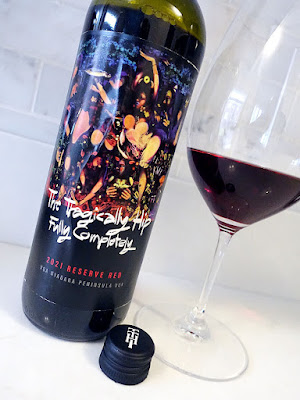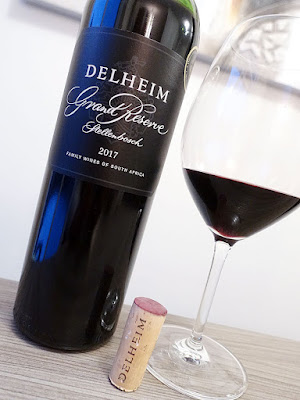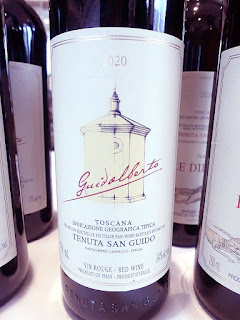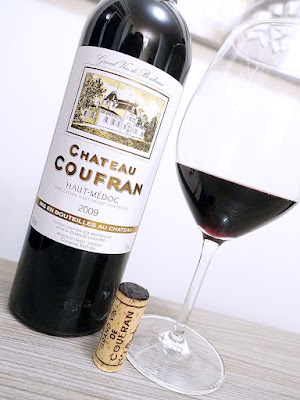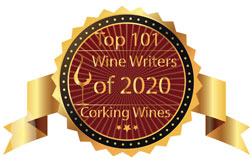red wine review is an excellent Bordeaux red from the Right Bank that arrived at the LCBO as the Wine of the Month in the LCBO VINTAGES Release Collection.
It is produced by Vignobles Gonfrier, a prominent, family-owned wine producer whose journey began when Paul Gonfrier and his wife, Marie-José, left their native land of Algeria in 1962 to start a wine business in Lestiac-sur-Garonne, Gironde, in the great wine region of Bordeaux. Paul bought Château de Marsan, which was in ruins at the time, but was surrounded by promising terroirs. He began the adventure with three hectares of grapes, then developed the property's arboricultural activity with the help of the entire family.
Paul's three sons became actively involved in the estate and in local life, with his eldest son, Pierre, becoming mayor of the local municipality, while Philippe became involved in running the property at a very early age, and the youngest son, Eric, carrying out his first vinification in 1985. The Gonfrier family continued to grow the estate with each passing year, with the objective of excellence: ensuring that each variety of grape is carefully selected to best express each plot's special characteristics, while also employing vinification techniques among the vines and in the cellar that seek to allow the terroir to express its finest qualities.
Today, Vignobles Gonfrier is led by brothers Eric and Philippe Gonfrier. Their recognition of exceptional quality wines has allowed them to acquire additional vineyards to further refine their blends. With over 1,000 hectares of vines, state-of-the-art equipment and facilities, the Gonfrier family goes out of its way to craft top-quality wines with sensitivity and respect for the concept of terroir. The third-generation of the family is also now involved in the family business, with Thibault, Philippe’s son, joining the company and expending great effort on taking care of the well-maintained vineyards in an environmentally respectful manner. In 2018, Thibault's sister, Audrey, also joined the company following her successful time spent at a Bordeaux wine merchant. Eric's three children are currently finishing up their studies and are eager to integrate into the family business by implementing new modern skills and knowledge. Their deep-rooted values are: passion for their work, respect for their clients, respect for their commitments, respect for the environment, and defence of their independence and freedom of action.
Château Tanesse is located in the Langoiran district of the AC Cadillac Côtes de Bordeaux appellation, a sub-appellation of the within the Entre-Deux-Mers wine region on the Right Bank of Bordeaux. Built in the second half of the 18th century by the Tanesse family, the Bordeaux charterhouse is located on a high hillock among Langoiran's sloping vineyards, and overlooks the commune's medieval 13th-century castle and offers a magnificent, panoramic view that stretches from the edge of the Sauternais to the outskirts of Bordeaux, while following the meanders of the Garonne River. The property is surrounded by a 30-hectare vineyard that sits atop very old foundations and has exceptional terroir.
This red wine is a blend of 55% Merlot, 40% Cabernet Sauvignon, and 5% Cabernet Franc that was grown on gravelly and clayey-gravelly slopes atop a calcareous subsoil in the vineyard surrounding the Château. The vineyard is managed using sustainable viticulture (certified HVE3), while the Gonfrier family is also committed to a Corporate Social Responsibility (CSR) approach certified by Ecovadis. The vines average 25 years old and were trained in the traditional Bordeaux-style, with two canes and a flat arch, along with controlled grassing-down of the vine rows or mechanical working of the soil in order to improve the soils' vitality and biodiversity. The grapes were manually green harvested, to allow for homogeneous distribution and proper aeration of the grape bunches, while also mechanically harvested. After destemming, crushing, and vatting, the grapes were fermented in temperature-controlled, stainless-steel tanks, with a prolonged maceration to extract tannins and showcase the terroir. And finally, the wine was aged for 12 months in French oak barrels.
Despite the pandemic, the 2020 growing season produced a legendary vintage. The growing season began with a balmy but frequently wet spring, which ensured both an early and successful budburst and flowering, while also putting the vineyards in good shape for the arrival of a hot and dry summer. Conditions were mostly arid throughout summer, with intermittent thunderstorms providing just enough water relief. The Right Bank had fewer deluges than the Left, but producers still had to be extremely vigilant at managing disease. Harvest took place during the chaos of COVID, but the weather in fall brought warm days and chilly nights, allowing the Bordeaux varieties to reach phenolic ripeness. While yields were slightly smaller than average, the fruit was healthy and of high quality. Let's see how this 2020 Bordeaux red wine is tasting tonight...
This blend of 55% Merlot, 40% Cabernet Sauvignon, and 5% Cabernet Franc is richly fragrant and inviting, with a medium-high to highly aromatic nose of lovely ripe dark fruits, black cherry, currant, cassis, and wood spice aromas surrounding a core of savoury earth and accented with graphite, mineral, and whiffs of rose floral. It's medium+ bodied and dry with ripe black cherry, currant, cassis, earthy, and graphite flavours in a well-balanced profile with crisp and juicy acidity. Accessible, medium-level tannins are well-structured and provide a nicely textured mouthfeel. Savoury with earthy and graphite notes linger on the long, gently grippy finish. Should drink nicely into the early 2030s. Highly recommended buy! Score: 90+ pts
Other fine wines by Vignobles Gonfrier can be ordered through their Agent - Sylvestre Wines & Spirits.
It is produced by Vignobles Gonfrier, a prominent, family-owned wine producer whose journey began when Paul Gonfrier and his wife, Marie-José, left their native land of Algeria in 1962 to start a wine business in Lestiac-sur-Garonne, Gironde, in the great wine region of Bordeaux. Paul bought Château de Marsan, which was in ruins at the time, but was surrounded by promising terroirs. He began the adventure with three hectares of grapes, then developed the property's arboricultural activity with the help of the entire family.
Paul's three sons became actively involved in the estate and in local life, with his eldest son, Pierre, becoming mayor of the local municipality, while Philippe became involved in running the property at a very early age, and the youngest son, Eric, carrying out his first vinification in 1985. The Gonfrier family continued to grow the estate with each passing year, with the objective of excellence: ensuring that each variety of grape is carefully selected to best express each plot's special characteristics, while also employing vinification techniques among the vines and in the cellar that seek to allow the terroir to express its finest qualities.
Today, Vignobles Gonfrier is led by brothers Eric and Philippe Gonfrier. Their recognition of exceptional quality wines has allowed them to acquire additional vineyards to further refine their blends. With over 1,000 hectares of vines, state-of-the-art equipment and facilities, the Gonfrier family goes out of its way to craft top-quality wines with sensitivity and respect for the concept of terroir. The third-generation of the family is also now involved in the family business, with Thibault, Philippe’s son, joining the company and expending great effort on taking care of the well-maintained vineyards in an environmentally respectful manner. In 2018, Thibault's sister, Audrey, also joined the company following her successful time spent at a Bordeaux wine merchant. Eric's three children are currently finishing up their studies and are eager to integrate into the family business by implementing new modern skills and knowledge. Their deep-rooted values are: passion for their work, respect for their clients, respect for their commitments, respect for the environment, and defence of their independence and freedom of action.
Château Tanesse is located in the Langoiran district of the AC Cadillac Côtes de Bordeaux appellation, a sub-appellation of the within the Entre-Deux-Mers wine region on the Right Bank of Bordeaux. Built in the second half of the 18th century by the Tanesse family, the Bordeaux charterhouse is located on a high hillock among Langoiran's sloping vineyards, and overlooks the commune's medieval 13th-century castle and offers a magnificent, panoramic view that stretches from the edge of the Sauternais to the outskirts of Bordeaux, while following the meanders of the Garonne River. The property is surrounded by a 30-hectare vineyard that sits atop very old foundations and has exceptional terroir.
This red wine is a blend of 55% Merlot, 40% Cabernet Sauvignon, and 5% Cabernet Franc that was grown on gravelly and clayey-gravelly slopes atop a calcareous subsoil in the vineyard surrounding the Château. The vineyard is managed using sustainable viticulture (certified HVE3), while the Gonfrier family is also committed to a Corporate Social Responsibility (CSR) approach certified by Ecovadis. The vines average 25 years old and were trained in the traditional Bordeaux-style, with two canes and a flat arch, along with controlled grassing-down of the vine rows or mechanical working of the soil in order to improve the soils' vitality and biodiversity. The grapes were manually green harvested, to allow for homogeneous distribution and proper aeration of the grape bunches, while also mechanically harvested. After destemming, crushing, and vatting, the grapes were fermented in temperature-controlled, stainless-steel tanks, with a prolonged maceration to extract tannins and showcase the terroir. And finally, the wine was aged for 12 months in French oak barrels.
Despite the pandemic, the 2020 growing season produced a legendary vintage. The growing season began with a balmy but frequently wet spring, which ensured both an early and successful budburst and flowering, while also putting the vineyards in good shape for the arrival of a hot and dry summer. Conditions were mostly arid throughout summer, with intermittent thunderstorms providing just enough water relief. The Right Bank had fewer deluges than the Left, but producers still had to be extremely vigilant at managing disease. Harvest took place during the chaos of COVID, but the weather in fall brought warm days and chilly nights, allowing the Bordeaux varieties to reach phenolic ripeness. While yields were slightly smaller than average, the fruit was healthy and of high quality. Let's see how this 2020 Bordeaux red wine is tasting tonight...
Tasting Note:
CHÂTEAU TANESSE 2020 - Sustainable, AC Cadillac Côtes de Bordeaux, France (#666628) (XD) - $19.95This blend of 55% Merlot, 40% Cabernet Sauvignon, and 5% Cabernet Franc is richly fragrant and inviting, with a medium-high to highly aromatic nose of lovely ripe dark fruits, black cherry, currant, cassis, and wood spice aromas surrounding a core of savoury earth and accented with graphite, mineral, and whiffs of rose floral. It's medium+ bodied and dry with ripe black cherry, currant, cassis, earthy, and graphite flavours in a well-balanced profile with crisp and juicy acidity. Accessible, medium-level tannins are well-structured and provide a nicely textured mouthfeel. Savoury with earthy and graphite notes linger on the long, gently grippy finish. Should drink nicely into the early 2030s. Highly recommended buy! Score: 90+ pts
Other fine wines by Vignobles Gonfrier can be ordered through their Agent - Sylvestre Wines & Spirits.





